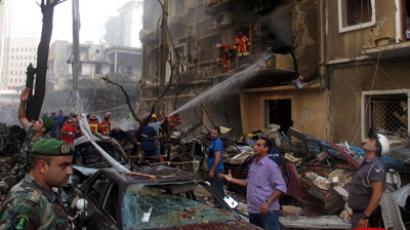Beirut bombing: Twin attacks target Iranian embassy, 23 killed, 146 injured
Two blasts near the Iranian embassy in Beirut killed at least 23 people, injuring 146 and causing havoc and a massive fire in the Lebanese capital. Six buildings were reportedly destroyed in the embassy compound.
The harrowing scene was primarily caused by 100lb (50kg) of explosives loaded into a car, according to AP. Security sources on the ground said there were two blasts - the first caused by a person on a motorbike carrying some 4.4lbs (2kg) of explosive, while the second was by a suicide bomber who tried to ram the compound with the car.
However, there are conflicting reports as to how the initial
blast unfolded. Eyewitnesses claimed that a man was mounted on a
motorbike, while a Lebanese official told Reuters that the man
wearing an explosives belt was seen rushing towards the embassy’s
outer wall before blowing himself up.
Witnesses at the scene reported that the explosions
occurred within one or two minutes of each other.
Injured people and destroyed buildings were seen on very disturbing pictures circulated by Lebanese media in the immediate aftermath.

Witnesses speaking to Al Arabiya reported seeing smoke rising
from the battered embassy compound, while footage from the bloody
scene showed raging fires, with the death toll rising by the
minute.
It is not clear who was behind the attack at this time, but the area where the blasts occurred is significant in two ways: it is considered to be a stronghold for the Lebanese Shiite faction, Hezbollah. And secondly, it is a popular area and a home to many families of Iranian diplomats working in Lebanon.

The Iranian ambassador to Lebanon reacted promptly to the
situation, saying that it was beyond any doubt that the embassy
was the target of the attack and placing blame on a "Zionist
entity." He added that such attacks only "keep us strong
and proves the righteousness of our stances." Minutes
before it was reported that the Iranian cultural adviser for
Lebanon was wounded in the blast, but shortly thereafter
succumbed to his injuries.
Later in the day Al-Manar found out that the Yemeni ambassador
was lightly injured in the blasts.
Iran's foreign ministry subsequently added that the blast was the
work of Israeli mercenaries. Syrian information minister Omran
Zoabi to Al-Manar has come out with a similar opinion, saying
that Israeli and Saudi intelligence are behind the explosions.
Later in the afternoon Reuters reported that Al-Qaeda-linked
Abdullah Azzam brigades have claimed responsibility for the
double suicide bombing.
Russian Foreign Ministry has condemned the attack saying that the
international community should give a “principled assessment
of this criminal action.”
Washington meanwhile urged the “parties to exercise calm and
restraint to avoid inflaming the situation further.” Acts of
terror only “reinforce our determination to work with the
institutions of the Lebanese state,” White House spokesman
Jay Carney said.
The UN Security Council and Secretary General have also released
statements that "strongly condemned" the atrocity.
The council appealed to “all Lebanese people to preserve
national unity in the face of attempts to undermine the country's
stability.” It “stressed the importance for all Lebanese
parties to respect Lebanon's policy of disassociation and to
refrain from any involvement in the Syrian crisis.”
Lebanon and Iran enjoy close relations, both having a large Shiite population. This is not the first attack that has occurred in the area. Hezbollah compounds have come under frequent fire before, especially as Sunni-on-Shia tensions have begun to mirror each other across the Middle East.

While an ally of Iran, Hezbollah is also a strong supporter of neighboring Syria’s President Bashar Assad, who is currently fighting his own terrorist threat.
Political bombings in Lebanon are a frequent occurrence. One of
the more severe recent ones took place in late August, when 42
people lost their lives, while literally hundreds were injured in
twin explosions in the city of Tripoli. Similarly, a blast near
Hezbollah’s headquarters just days before, on August 15, killed
27 people, injuring 150.
Sunni radicals claimed responsibility.
In June, the same location was targeted, when a car bomb blast injured 53 people.

















